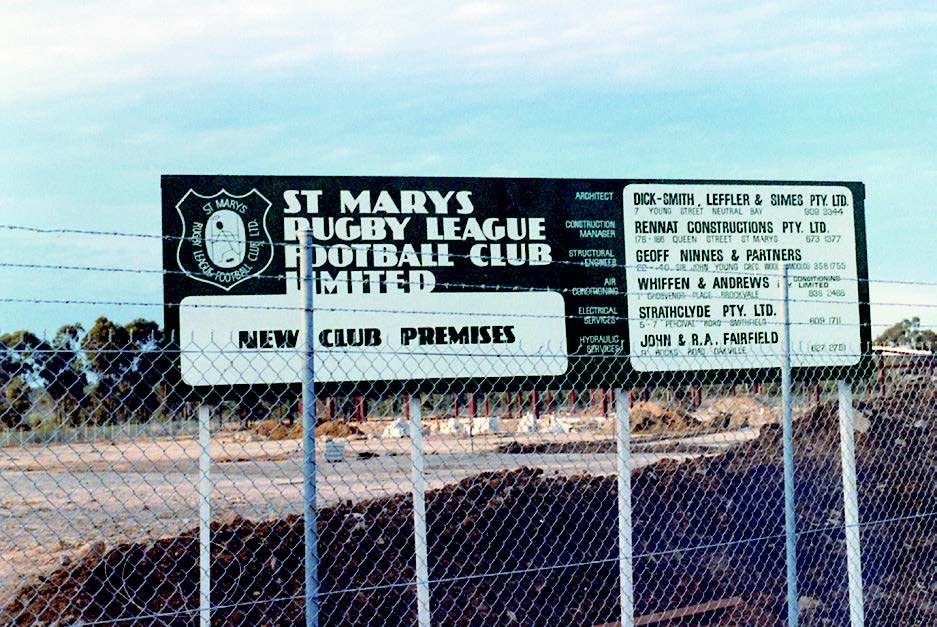Remembering Tony Dicker
Tony Dicker was at the forefront of St Marys Rugby League at several crucial times in the Club’s history. He started his playing career as a junior in the early 1950s when the Club was building up after years in the doldrums.
In the late 1960s, he turned out for A-Grade, coached A-Reserves, and was on the Junior League Committee—all at the same time. He was there again in 1970 when the Club entered Second Division and toiled for another six years until his retirement as a player in 1975.
Bill Webster approached Tony Dicker, Tony Mitchell and Graeme DeLanoue to stand for the Board in 1972. At that point Saints was in Second Division and Bill was doing pretty much everything with the various committees. The three stalwarts made it their job to take over the fundraising allowing Bill to focus on obtaining a liquor licence. Their week was spent running raffles, training, playing football and preparing the grounds on weekends which took its toll on jobs and marriages. Tony Dicker would also go to schools to recruit players for the Saturday junior teams, he helped bring in the ‘500 Club’ raffles to raise money for end of season trips and implemented game day procedures for collecting and receipting money.
Before St Marys could be granted a liquor licence it needed a solid core of members. Raffle money was put towards paying membership fees, and it was made a rule that you had to be a member to play for the Club. A lot of people paid membership fees when there were no club facilities – they were paying for the future.
The hard work paid off in 1981 when St Marys Rugby League Club was granted a licence, and then in 1982 when the Club opened for trade on Melbourne Cup Day. Tony Dicker was President of the Board at that time, a position that he retained until 1986.
Not wanting to be a financial drain on the leagues club in its formative years, for the first five years of operation the Football Committee did not ask the Club for a grant, they continued with raffles and donations. The early 1980’s was a time of recession and random breath testing had just come in which impacted on revenue.
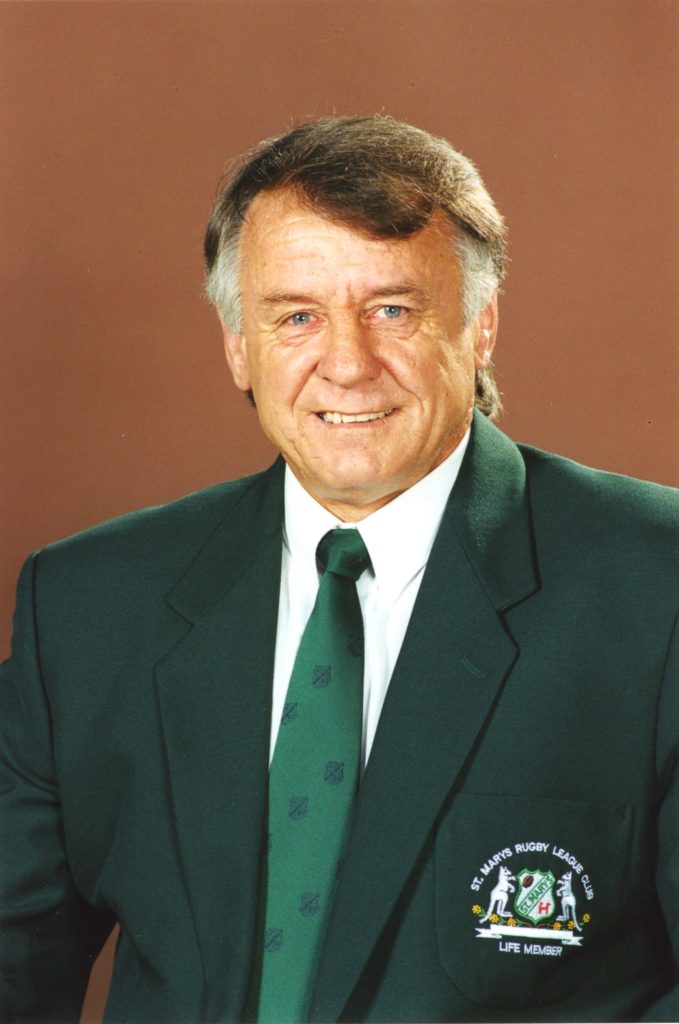
Tony Dicker joined the Board at the Club’s lowest ebb and worked tirelessly to keep St Marys Rugby League Club, and the dream of a licensed club alive.
In 1972 Tony was the recipient of the prestigious Life Members Trophy which recognises the best clubman on and off the field. He saw sons Simon and Ben emulate his achievement in 1993 and 1995 respectively. Simon and Ben Dicker both serve on the Board of Directors.
In 2012 the Board introduced the Tony Dicker Award, presented annually to the Club’s most successful and outstanding side.
Remembering Tony Mitchell
Tony Mitchell—known either as ‘Bluto’ or ‘Mitch’—is one of the real characters in the history of the St Marys Club. A St Marys junior, ‘Mitch’ played for the Club during the 1960s, before captain-coaching the Club to A-Grade premierships in 1977–78.
Winner of the Life Members Trophy in 1975, Tony also joined the Board of Directors in the 1970s and served as Club President from 1986 to 1989.
Tony Mitchell witnessed a generational change in the Club’s fortunes, from the premiership years of the 1960s, through the tough times of the 1970s, to the opening of the Leagues Club in the 1980s. In between were countless matches, hundreds of weekdays and weekends preparing the grounds, sometimes Tony would even turn up to Board meetings wet after stopping at the ground to set up the sprinklers.
Tony Mitchell was one of the many men and women during the 1970s who contributed to the survival of the Club and who took on a variety of weekly and game-day tasks to get St Marys Park ready each weekend on a shoestring budget. They would even have to get the toilet trough out of storage, empty it at the end of the day and clean it for the following week. Some rival clubs refused to use the grounds’ amenities because they were in such a terrible state. Penrith City Council offered a solution to the problem, they would build a new toilet and shower block at St Marys Park if the football club sign over the entire property.
The Committee rejected the offer and the club later sold the ground for close to a million dollars which was instrumental in establishing a licensed premises and securing the club’s future.
The ‘two Tonys’—Dicker and Mitchell—were considered in discussion for Life Membership with the Club in 1980. With only one successful applicant in a given year, it is a source of some pride and amusement for Tony Mitchell that his mate was successful first, because it was felt by some people in the Club that he “swore too much”. Tony Mitchell was eventually recognised by the Club in 1983.
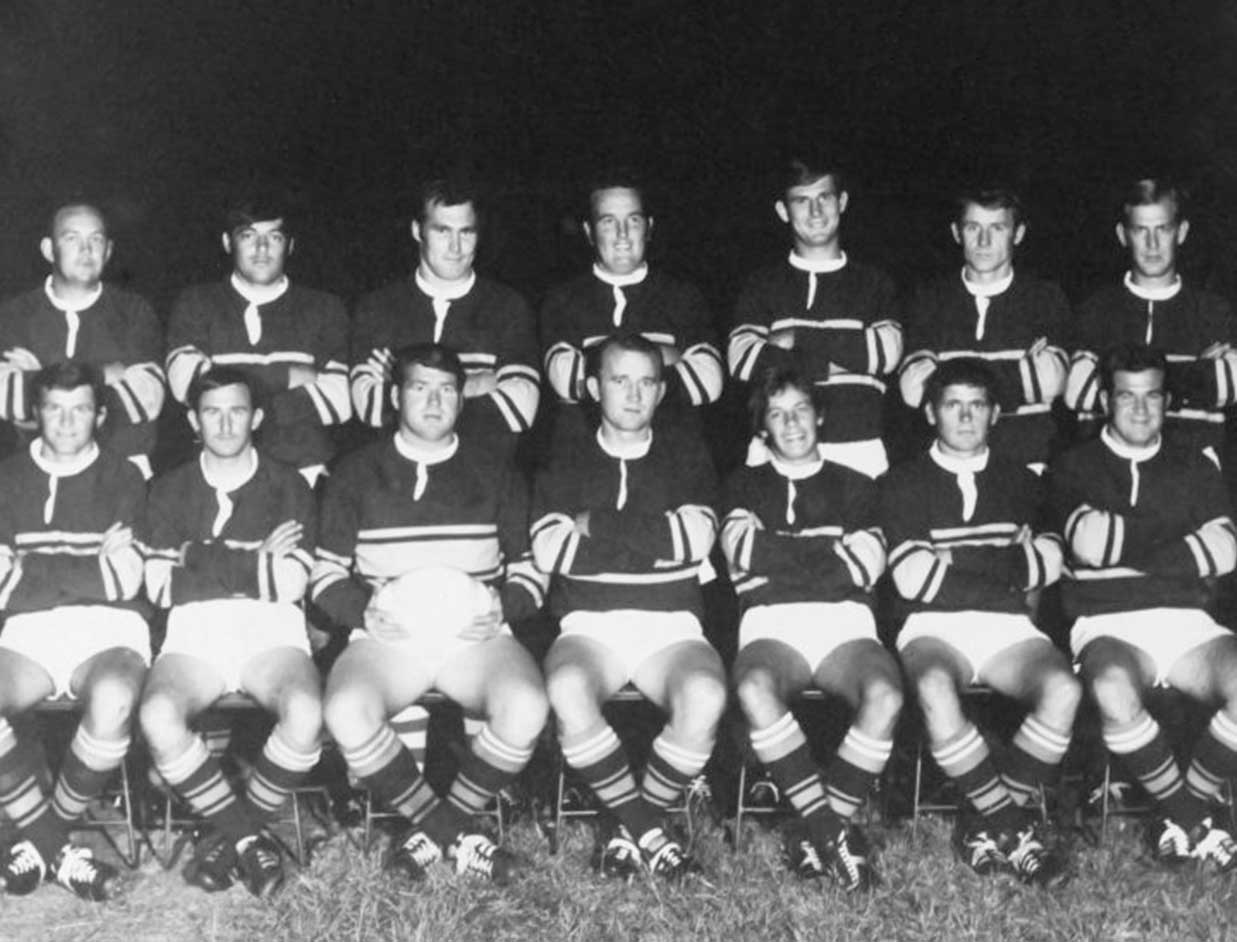
St Marys First Grade (Second Division), 1970.
Back row: Cec Reddy, Tony Mitchell, David Curry, Barry Clarke, Joe Ulanus, Tony Dicker, Doug Falconer. Front row: Les Barwick, Kevin Gibson, Graham Rogers, Terry Hiedtmann, Bill Duchnicz, Ken Davis, Lance Kneller.
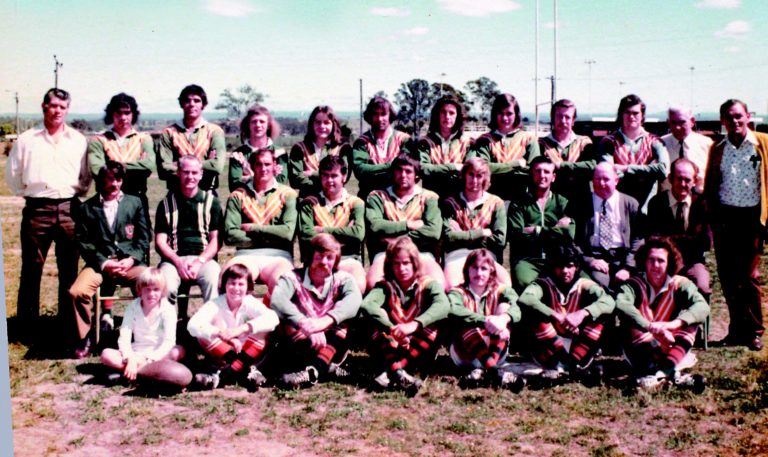
St Marys First Grade Second Division
Grand Finalists, 1974 (vs. Ryde-Eastwood).
Back row: Ivan Edwards, Ray Blacklock, Ron Mason, Kevin Johnston, Peter Cornell, John Stapley, Kevin Bennett, Les Trist, Mick Day, Robert Ryan, Jack Kilburn, Ted McLean (Com). Middle row: Joe Stubbs (Selector), Bill Webster (Secretary), Allan Cobb, Graeme Ceiley, Tony Mitchell, Jeff Breadsell, Bill Koegh (Coach), Kevin Reed (Time Keeper), Phil Farmer (Asst Secretary).
Front row: Terry Farmer, Dennis Webster (Ball Boys), Graeme Delanoue, Bill Duchnicz, Kevin Gibson, Noel Kitchener, John Burns.
Footy Field Flashbacks
In 1955, St Marys Rugby League Club entered into the most ambitious plan in the Club’s history—to purchase and develop its own playing fields and amenities, in the first step to becoming a fully-licensed Leagues Club. Prior to that the Club called Victoria Park home and paid Penrith Council 20 guineas for use of the park.
Once the Club Committee, under Clive Randerson’s leadership, had secured the support of local businesses, and new and old players alike, St Marys set about looking for a suitable site to develop. They found 9.5 acres of land in the centre of town, owned by Mr Harry Shaw, a farmer who at the time owned the whole area where the St Marys Village Shopping Centre now stands.
After approaching Harry Shaw, the St Marys Committee was pleased to learn that he would sell the land for community use for £2500. All the Club had to do was raise the funds.
When it was decided to buy the ground from Harry Shaw, the Club was informed by the government department responsible that no single sporting body could purchase an area of land that size. It was then decided to buy the land under the name of the St Marys Athletics Society which had been dormant for some years.
The Athletics Society reactivated its membership and raised funds for the purchase of the land while the Rugby League Club raffled a Holden car in an Art Union raffle. The ‘Car Club’ was formed by 200 members and supporters who put in £20 pounds each (or a pound a week for 20 weeks), with first prize being a new Holden Special, valued at £1044 at the time, supplied by Lance Motors of St Marys. Car yard owner Ian Lance was a great St Marys supporter, and proceeds from these raffles swelled the Club’s finances to a position where it could afford to buy the land, and even build a clubhouse.
The land was purchased in the name of the Athletics Society, with the agreement that St Marys Rugby League would administer the Park for the purpose of all local sports, but with the aim of transferring the land fully to the Rugby League Club in the future.
Through hard work, and with volunteer labour from the Football Club, the ground started taking shape. A weatherboard building known as “The Green shed” was also built for change rooms and showers, and a place to hold Club meetings and socials.
Whilst the Club could now boast that it owned its own football oval, the facility had its drawbacks. Sewerage was not available and all the ground and building maintenance had to be carried out by volunteers. Penrith Council could not assist with ground maintenance because the land was privately owned, so all costs had to be absorbed. The Club’s only sources of income during this time were local business sponsorships, donations, and funds raised by the Football Committee from raffles at local hotels and at the ground on game day.
By the mid 70s St Marys Park had fallen into disrepair and become an embarrassment to the Club. It was written in Rugby League Week how brave St Marys players were to play on the ground and some opposing sides refused. For the Club, the solution was simple… sell the land and start again.
However, the sale of the property was not as easy as anticipated. It took many years to convince Penrith Council to rezone the site where St Marys Village shopping centre now stands, and then the Club ran into another obstacle, the State Planning Authority ruled that no major retail store could be built within a certain radius of Mount Druitt Shopping Centre. With the help of Penrith Council and the then local member for St Marys, Mr Ron Mulock, the Club was able to finally sell the property in 1980 for almost a million dollars.
Proceeds from the sale were used to purchase and develop the site where St Marys Rugby League Club now stands. The licensed premises at the corner of Forrester and Boronia roads first opened for trade on Melbourne Cup Day 1982 and supports the Club’s core objective, to propagate the game of rugby league.
The Belles of St Marys
The Belles of St Marys were Saints first women’s rugby league side. They came into being in September 1955 when they challenged the Club Committee to an end-of-season Charity Day match. Their name was a clever pun on the title of a popular Bing Crosby movie of the era—The Bells of St Mary’s (the sequel to the Oscar-winning Going My Way)—but there was nothing subtle about their style of play. A committeeman who survived the match said later, “I was never so terrified. They ripped up the rule book and came at me claws and all. I feigned injury to get off the field.”
The Belles, secretly coached for the clash by former Parramatta first-grade player Rolf Trudgett, demolished the men’s team led by Club President Clive Randerson. The unusual match completely overshadowed the main events of the afternoon—the A-Grade and A-Reserve exhibition matches against Maroubra. The money raised that day was shared between Nepean Hospital, St Marys RSL, and the Club’s newly-formed Ladies Auxiliary.
Following the game, the Belles were all set to return to their respective scenes of domestic bliss, but the ‘Rubies’, a team comprised meatworkers’ wives and working girls from nearby Riverstone, issued a challenge. For this match, The Belles were coached by Brian Grace and Fred Poynting. They took on Riverstone on 2 June 1956 in front of 3000 spectators at the newly-opened St Marys Athletic Society Park. There was no love lost between the two teams, but St Marys reportedly gave their ‘Rivo’ sisters a shellacking, winning eight points to nil.
Flushed with success, The Belles accepted a challenge from a Queensland representative team, the Queensland ‘Bonfires.’ The match was widely promoted in the press, and the St Marys Club pulled off a major coup when they secured the services of Australian Test captain Clive Churchill, then at the height of his legendary career, as celebrity referee. The Belles attracted newsreel and even fledgling television coverage (TV started in September of that year). A huge crowd was all but guaranteed and bound to put the limited facilities of the Club under pressure.
The match was played on Sunday 22 July 1956. One report of the match noted, “More than 12,000 spectators jam-packed the oval to see the feline display of uninhibited ferocity, fanned then, as it still would be, by intense interstate jealousy.”
Today, Saints has over 250 females registered to play. As participation continues to grow, the Club continues to develop pathways and opportunities for girls and women to excel. Saints who have already achieved representative status include; Kelly Rhodes (Australia), Kylie Egan (Australia), Sarah Togatuki (NSW and Samoa), Kimberly Nikua (Tonga), Abbi Church (NSW RL Country), Christian Pio (NSW RL City), Rikeya Horne (NSW RL Country), and Samantha Economos (NSW RL Country).
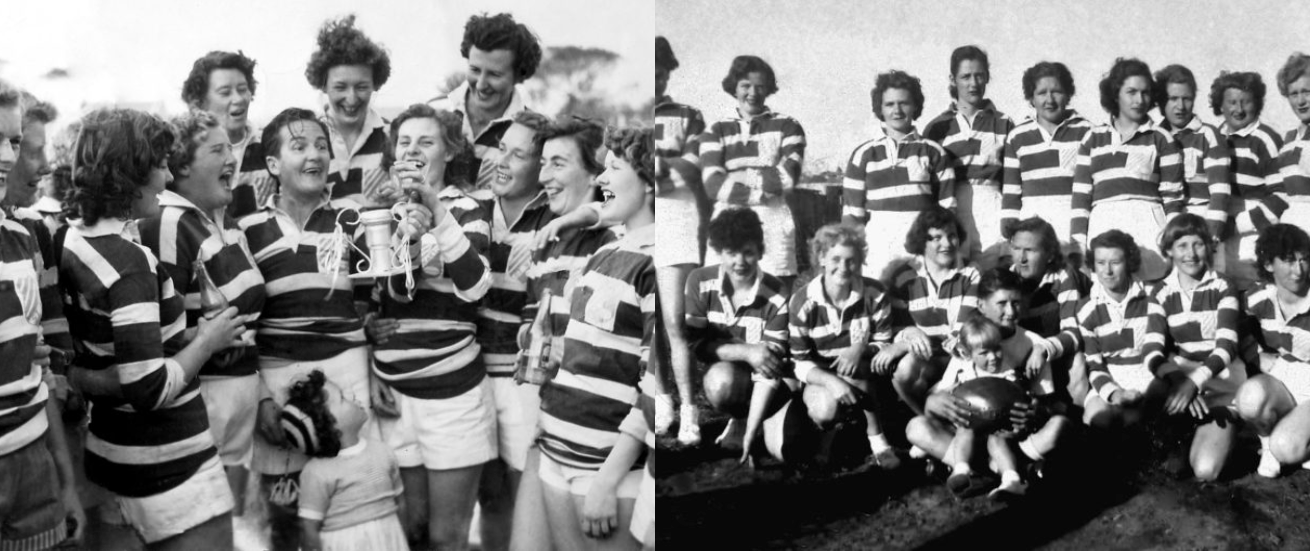
History of the Club’s Licence
It was determined by the men working behind the scenes at St Marys Rugby League in the late 1950s that if the Club was to build on its earlier successes, it had to look at obtaining a licence as a registered club. Penrith had shown St Marys that a club had to have a much higher source of finance to maintain teams at the highest level, develop their junior ranks, and follow the trend of securing a higher standard of player with financial offers.
By the end of the 1960s, the Club started working to make this dream a reality. Despite the great success St Marys enjoyed on the playing field in the early 1960s, the Club was not in a financial position to apply for registration as an incorporated club until late 1965. On Christmas Eve in 1965, St Marys Rugby League Football Club Limited was incorporated as a company by uniting the existing Rugby League Club and Junior League into a single entity under the administration of one Board of Directors.
The Club owned their home ground, the site where St Marys Village now stands after purchasing it in the 1950s for £2500. In 1980, the Club sold the site for close to $1 million which provided the funds to purchase a new site and build a registered club. Seventy-five acres of land was purchased in December 1980 for $470,000. The newly-purchased land had 50 acres zoned for housing and roads, and 25 acres zoned for industrial use. In April 1981, Penrith City Council and the State Planning Authority passed a vote to allow development on the 50 acre section of land, leaving the smaller portion not to be touched.
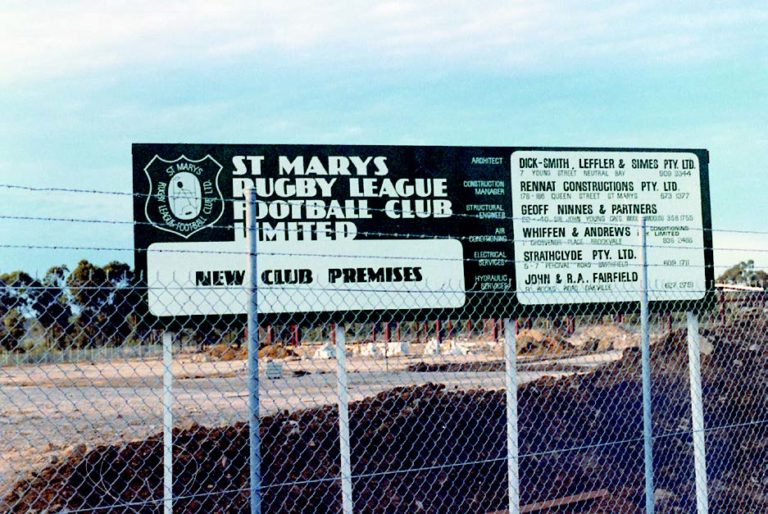
While the Club was awaiting the rezoning decision, it bought a further three-and-a-half acres from Hotels Australia as well as a hire company on the corner of Forrester Road, which gave the proposed development a better frontage. Further rezoning took place, and approval was given to go ahead with the building of the Leagues Club on 31 March 1982.
The licensed premises opened for trading on Melbourne Cup Day 4 November 1982. Since then, the licensed premises and the St Marys Rugby League Club site has developed considerably with the extension of St Marys Rugby League Club and the construction of St Marys Leagues Stadium (2002), Go Bananas (2010), Holiday Inn Sydney St Marys (2018) and Saints Event Centre (2022).
Rugby League Beginnings
St Marys United Rugby Union Football Club won the 1908 district rugby competition, but it appears the locals would play rugby union on Saturday and then back upon Sunday for a rugby league game against other district teams.
These social or picnic games were not recorded, because to do so would have meant expulsion from the powerful Metropolitan Rugby Union, which managed the amateur code at the time.
Enlistments into the armed forces during World War I (1914-1918) seriously affected both football codes, the rugby union competition was abandoned altogether and the whole thrust of forming a viable league competition was brought to a stop.
In 1916, an inter-town rugby league competition known as the Lakerstein Cup commenced in the district. Organised without any administration, the teams originally involved were Penrith, St Marys, Wallacia and Emu Plains, and this competition continued in one form or another for the next two decades. Regular rugby league competition was formalised in the district in 1920, after many of the local men returned from the war.
From these earliest days, St Marys wore the colours of green and white, and were known as ‘The Greens’ or merely ‘Saints’. The number of Irish settlers in the area – especially those who owned the land known as Victoria Park on the southern side of the Great Western Highway where the club later played their home games, made the selection of playing colours a foregone conclusion.
In 1920 it was decided the then newly formed St Marys Football Club would enter the Parramatta District League Competition, and train two nights a week. The membership fee was fixed at 2s/6d. The club played its first match on Saturday 14 April 1920 in a practice game against Blacktown on Victoria Park. A keenly contested battle was witnessed by a good crowd, and a dance was held in the Protestant Hall the following week to aid the Club’s fundraising efforts.
Today Saints has over 1000 registered players competing in the local Penrith and Districts Junior Rugby League and the higher tier NSW Rugby League men’s and women’s conference competitions.
With the support of the leagues club, St Marys Rugby League Club continues to propagate the great game of rugby league, providing pathways and encouraging boys, girls, men and women to reach their full potential.
Many former Saints have gone onto achieve the highest level of rugby league including John Cartwright (NSW and Australia), Mark Geyer (NSW and Australia), Tony Puletua (NZ and Samoa), Frank Puletua (NZ and Samoa), Peter Wallace (NSW), Michael Jennings (NSW and Australia), Tim Grant (NSW), Geoff Daniela (Cook Islands), Jarome Luai (NSW and Samoa), Maika Sivo (Fiji), Brian To’o (NSW and Samoa), Siosifa Talakia (NSW), Moses Leota (NZ and Samoa), Kelly Rhodes (Australia), Kylie Egan (Australia), Sarah Togatuki (NSW and Samoa) and Kimberly Nikua (Tonga).
We continue to see Saints players debuting in the NRL achieving representative status.


